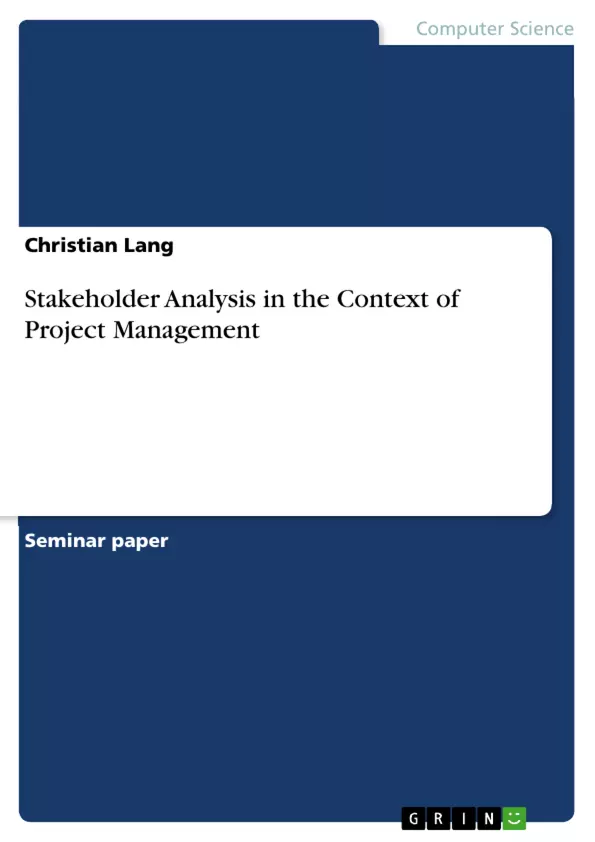Due to the change in our society from an industrial society to an information society, the number of projects in companies is increasing and at the same time their degree of complexity. This complexity of projects brings with it a number of problems. One of them is the number of stakeholders, which also increases as the size of the project increases. A stakeholder is a person or a group of people who are positively or negatively affected by the project or its product. In short, a person who has an interest in the project. Thus, as the number of stakeholders increases, so does the diversity of interests. When there is a diversity of interests, sooner or later conflicts will naturally arise. These conflicts can significantly jeopardise the success of the project.
Stakeholder analysis is a way to deal with this problem. It is typically divided into the steps of identification, classification and assessment and is carried out either as part of a project environment analysis or as part of stakeholder management.
Due to the importance of stakeholders and their incongruent interests with regard to the project, as described above, it is obvious that a stakeholder analysis is a critical success factor for projects. Based on the results of three studies from 2006-2008 by the German Association for Project Management (Deutsche Gesellschaft für Projektmanagement e.V., GPM). (GPM), this was examined for its truth content.
The thesis could not be easily proven. Although the results of the studies suggest a high importance of communication in the project and of stakeholder management, it cannot be concluded beyond doubt that stakeholder analysis is a critical success factor for projects. Nevertheless, it can at least be recognised that stakeholder analysis plays a weighty role for recognised critical success factors such as project communication or stakeholder management. Stakeholder analysis lays the foundation here.
Table of Contents
- Management Summary
- Introduction
- What is a stakeholder?
- Classification in project management
- Stakeholder analysis as part of a project environment analysis
- Stakeholder analysis as part of stakeholder management
- Procedure of a stakeholder analysis
- Identifying stakeholders
- Classification of stakeholders
- Assessment of stakeholders
- Critical consideration
- Stakeholder analysis - A critical success factor for Projects?
- Conclusion
Objectives and Key Themes
This work investigates the role of stakeholder analysis in project management, specifically examining whether it is a critical success factor for projects. It aims to evaluate the importance of stakeholder analysis in today's complex project environments.
- The significance of stakeholders in projects
- The process and methods of conducting stakeholder analysis
- The potential challenges and limitations of stakeholder analysis
- The relationship between stakeholder analysis and project success
- The application of stakeholder analysis in real-world project scenarios
Chapter Summaries
- Management Summary: This section provides a brief overview of the work, highlighting the increasing complexity of projects and the importance of stakeholder analysis in managing diverse interests and potential conflicts.
- Introduction: The introduction sets the context for the work by discussing the economic and social changes that influence the complexity of projects. It emphasizes the crucial role of stakeholders and introduces the thesis that stakeholder analysis is a critical success factor for project management.
- What is a stakeholder?: This chapter defines the concept of a stakeholder, explaining who they are and why they are important in projects.
- Classification in project management: This chapter explores different ways in which stakeholder analysis can be integrated into project management, specifically within a project environment analysis and stakeholder management.
- Procedure of a stakeholder analysis: This chapter details the typical steps involved in conducting a stakeholder analysis, including identification, classification, and assessment of stakeholders.
- Critical consideration: This chapter examines potential challenges and limitations associated with implementing stakeholder analysis.
Keywords
Key terms and concepts explored in this work include stakeholder analysis, project management, critical success factors, stakeholder identification, stakeholder classification, stakeholder assessment, project environment analysis, stakeholder management, and project complexity.
- Quote paper
- Christian Lang (Author), 2009, Stakeholder Analysis in the Context of Project Management, Munich, GRIN Verlag, https://www.grin.com/document/1150466



